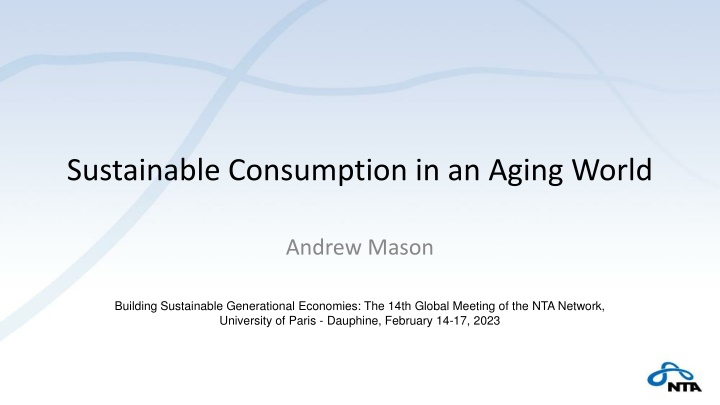Sustainable Consumption in an Aging World: Challenges and Solutions
Addressing the sustainability of current consumption levels amidst global population aging is crucial. Through exploring policies to enhance sustainable consumption and utilizing data on consumption, labor income, and demographics, this study presents a model that analyzes wealth profiles for Japan. Focusing on issues like reforming pensions, increasing retirement age, and achieving sustainability, the research emphasizes long-term strategies for building generational economies.
Download Presentation

Please find below an Image/Link to download the presentation.
The content on the website is provided AS IS for your information and personal use only. It may not be sold, licensed, or shared on other websites without obtaining consent from the author.If you encounter any issues during the download, it is possible that the publisher has removed the file from their server.
You are allowed to download the files provided on this website for personal or commercial use, subject to the condition that they are used lawfully. All files are the property of their respective owners.
The content on the website is provided AS IS for your information and personal use only. It may not be sold, licensed, or shared on other websites without obtaining consent from the author.
E N D
Presentation Transcript
Sustainable Consumption in an Aging World Andrew Mason Building Sustainable Generational Economies: The 14th Global Meeting of the NTA Network, University of Paris - Dauphine, February 14-17, 2023
Reform pensions? More than ever, we need to remind our Members of Congress that Americans 50+ voted them into the very seats they occupy today. The AARP community is nearly 38 million strong, our voices are powerful, and we don t back down from a fight especially when it comes to saving Social Security. - AARP (American Association for Retired People) Email message from AARP advocacy on Jan 21, 2023.
Work longer? On January 19, 2023 over 1 million French protest against raising the retirement age from 62 to 64. Place de la Republique, Paris (AP photo/Lewis Joly)
Introduction Two issues Are current levels of consumption sustainable in light of population aging around the world? What policies might be pursued to increase sustainable consumption? Method for addressing the issues NTA data on consumption and labor income Demographic data from UN World Population Prospects Simulation model
Model Features Steady state analysis that emphasizes the long-run and deemphasizes dynamics Fertility and mortality are exogenous; no immigration Reallocations systems are different for children and seniors Interest rates respond to changes in population growth Consumption profile shifts to achieve sustainability Sustainability is assessed using the lifecycle profile of wealth
Sustainable wealth profile for Japan Wealth consists of assets plus transfer wealth. Lee and Mason, Population Aging and the Generational Economy; UN NTA Manual. Survival weighted per capita longitudinal values Accumulating child debt Paying off child debt Based on work by Lee and by Willis.
Sustainable wealth profile for Japan Survival weighted per capita longitudinal values Accumulating pension wealth Drawing down wealth
Solving for consumption level to achieve sustainable lifecycle wealth Age of shift in lifecycle phases is endogenous Final wealth is zero Initial wealth is zero Discount rate is weighted average of biological rate and market rate Discount rate is biological rate Biological rate is rate of population growth plus rate of productivity growth (Samuelson 1958.)
Illustration of Model: Application to Japan Following questions are addressed: Is current level of consumption sustainable? How will sustainable consumption be affected by Increase in life expectancy? Increase in fertility? Greater reliance on funded program rather than transfers to support old-age needs
Application to Japan Assumptions for baseline calculations Exogenous factors Japan Baseline value Source Constant TFR 1.29 WPP estimate for 2019 Constant population growth rate -1.6% Calculated from TFR with generation length of 30 years. Constant mortality e0 = 85.6; e60 = 27.6 WPP Projections for 2025 Child transfer share 100% Used for all countries Old-age transfer share 49.8% Japan estimates from Lee and Mason 2018 Consumption and labor income profiles See figures Japan NTA 2014 estimates from Ogawa and Matsukura Productivity growth rates 1.5% Used for all countries
Baseline vs sustainable consumption, Japan Survival weighted, per capita labor income for the cohort (based on 2014 NTA)
Baseline vs sustainable consumption, Japan Survival weighted, per capita consumption for cohort (based on 2014 NTA)
Baseline vs sustainable consumption, Japan Sustainble survival weighted, per capita consumption is 79% of baseline values.
Affect on Sustainable Consumption of Longer life expectancy Higher fertility Greater reliance on funded old-age reallocations?
Effects of higher life expectancy 2025 (e0 = 85.6; e60 = 27.6) vs 2065 (e0 = 90.4; e60 = 31.5) At most ages survival weighted consumption declines from 79% to 76% of baseline At older ages survival weighted consumption rises
Baseline consumption and sustainable consumption given TFRs of 1.29 or 1.75 Higher fertility: consumption 84% of baseline. Lower fertility: consumption 79% of baseline.
Baseline consumption and sustainable consumption given funded old-age reallocations: 49.8% or 66.7% share Higher share funded With increased emphasis on funded old-age reallocations, consumption would rise to 83% as compared with 79% of baseline.
Summary of application to Japan Is current level of consumption sustainable? No. Sustainable consumption is only 79% of current consumption. How will sustainable consumption be affected by: Increases in life expectancy? Projected increase over the next 40 years. Small effect on those below age 70. Survival- weighted consumption will be much higher for the very old Increase in fertility? Rise in TFR from 1.29 to 1.75 Increase in sustainable consumption by 5 percentage points. Greater reliance on funded program rather than transfers to support old-age needs? Increase in funded share from about to 2/3. Increase in sustainable consumption fy 4 percentage points.
Qualifications Application is to Japan but the methods are general and can be readily applied to countries with NTA. Demographic change that leads to aging has favorable effects not addressed in this presentation Value of a longer life Improved reproductive health Second dividend effects (increases in human and physical capital) Reform often meets considerable resistance























